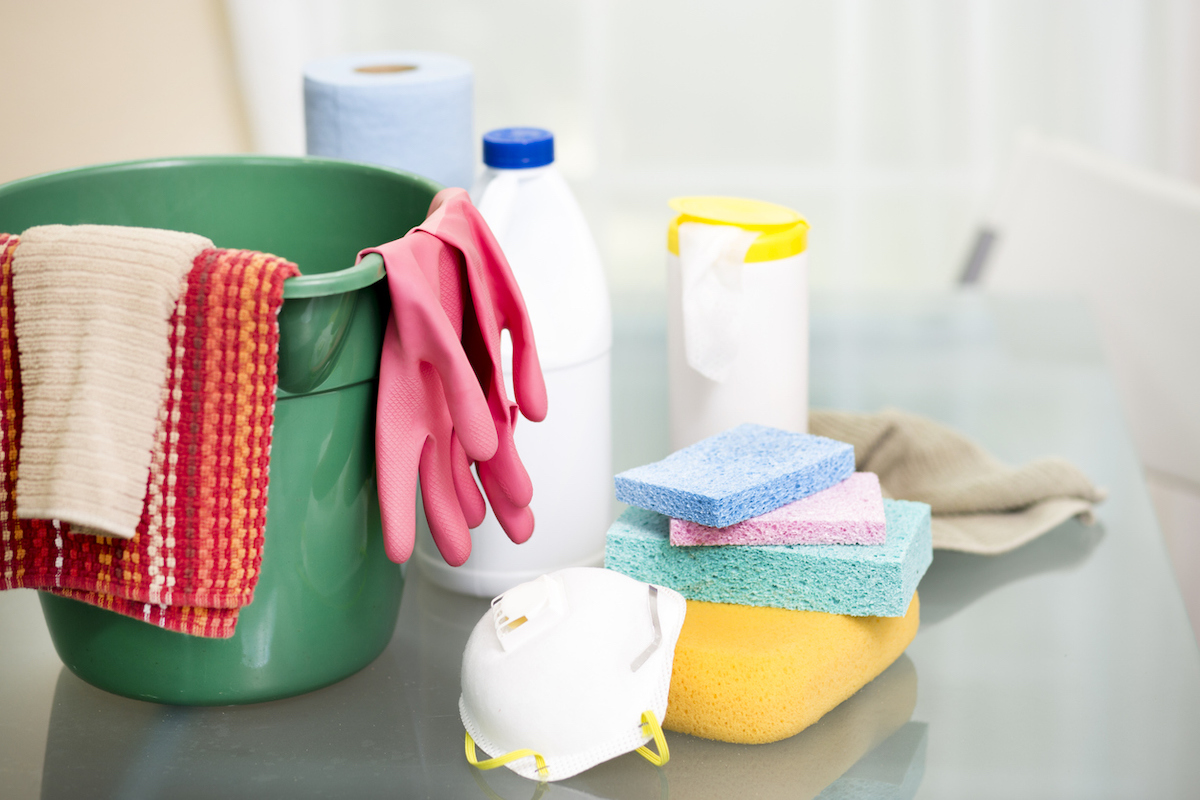

We may earn revenue from the products available on this page and participate in affiliate programs. Learn More ›
Q: I found a few old bottles of bleach while cleaning and organizing my laundry room. They’re all long since expired, so I want to get rid of them to clear up more space. I know bleach can be dangerous if it isn’t handled correctly, but I don’t know how to dispose of bleach. What’s the best bleach disposal method?
A: Bleach and its main ingredient, sodium hypochlorite, can indeed be dangerous. Exposure to bleach can irritate a person’s eyes, mouth, or skin, and it can even cause breathing problems or burn tissue. Dumping undiluted bleach outside can also harm local wildlife and interfere with plants’ ability to absorb necessary nutrients.
Keep in mind that bleach is considered hazardous waste in some cities and states. Your local government may have specific laws or regulations in place regarding its disposal, which you’ll want to look into before trying one of the methods shared below. If you need to dispose of bleach, keep these facts in mind to avoid health, safety, and ecological risks. When it comes to how to dispose of bleach safely, there are a few different options you can try.
RELATED: 15 Cleaners That Can Do the Most Damage
Store leftover bleach for later use or donate it.
Rather than disposing of bleach that has yet to expire, consider storing it for later. Anywhere you store bleach should also be a cool and dry place that isn’t exposed to direct sunlight. Before placing bleach on a shelf or cabinet, always check to make sure that the cap is sealed tightly, and always store bleach in its original bottle. If you have young children in your home, store bottles of bleach up high in a locked cabinet.
However, bleach does expire eventually, even with proper storage. While manufacturers don’t always list an expiration date on bleach bottles, the chemical starts to degrade after about 6 months and then loses around 20 percent effectiveness each year. Pouring it into a clear container or spray bottle will cause it to degrade more quickly, making it even less effective.
If you don’t think you’ll be able to use extra bottles of bleach you have, consider giving it to a friend, family member, or neighbor who will be able to use it before it expires.
Dispose of bleach at a local hazardous waste facility.
For safe disposal of sodium hypochlorite bleach, consider bringing it to your local hazardous waste facility. Depending on where you live, your local government may actually require or strongly recommend this option over pouring the bleach down the drain.
If you’re not sure where a hazard waste disposal facility is in your area, you can search online or contact your local government offices. For disposal of bleach with these facilities, you’ll likely just need to bring the bleach to the drop-off point in its original container (leak-free). There may be limits on how much bleach and other hazardous waste materials you can drop off at one time. Before driving to the facility, check to see if any such regulations are in place.
RELATED: The Best Natural Cleaning Products, Tested and Reviewed

Diluted bleach can be poured down a drain (sparingly).
When you add bleach to a load of laundry or use bleach to disinfect household surfaces, it goes down the drain with the wastewater. However, this does not mean that you can simply pour a full bottle of bleach down the drain and call it a day. When you do laundry or clean with bleach, the bleach that enters the pipes is heavily diluted with water.
When pouring bleach down drains for disposal, you’ll need to keep this same principle in mind. It can be done (in most cases), but you must always dilute the bleach with a lot of water. Use a minimum of 1 gallon of water for every ⅓ cup of bleach. Remember, you should never mix bleach and vinegar, so avoid pouring these two liquids down the drain together.
If you have a septic system, consider an alternative disposal method, particularly if you have a lot of bleach to get rid of. If the concentration of bleach inside the septic tank gets too high, it could potentially interfere with the balance of bacteria. Also, avoid regularly pouring bleach in garbage disposal drains. Over time, it can cause damage to the blades.
There are a few other precautions you should take when pouring bleach down the drain. First, be sure to work in a well-ventilated room to minimize inhalation of the substance. Then, don some gear to help protect your eyes and skin from splashes, including a pair of protective goggles, a pair of gloves, and a long-sleeved shirt. You may want to wear an apron or old clothes. This way, if the bleach splashes on your clothing, you won’t ruin a favorite shirt or pair of pants.
Rinse and recycle empty bleach containers.
After using up a bottle of bleach for laundry and cleaning purposes or choosing an appropriate bleach disposal method, you will need to get rid of the jug. In most cases, you can recycle the empty bleach container, but you may want to confirm that with your local recycling center. Before placing the empty jug in the recycling bin, rinse it thoroughly to remove as much bleach residue as possible. After rinsing, put the lid back on the container, and place it in your recycling bin or bring it to a recycling center.
